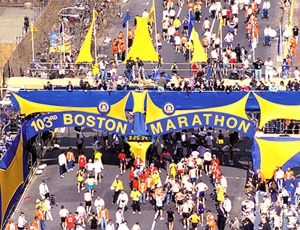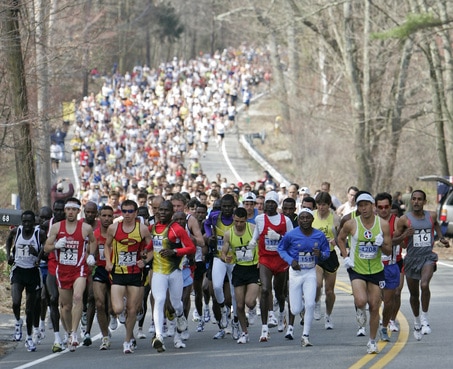
Qualify for the Boston Marathon
My blog is getting a lot of traffic from people looking for Boston Marathon qualifying information, with searches like “How fast do I have to run to qualify for Boston Marathon” and “Boston Marathon training plan.” They are landing on my previous post How I Plan to Qualify for the Boston Marathon, which was geared toward my specific training to qualify for Boston 2010. I’m writing this continuation in order to compile some more general Boston Marathon qualifying information which might be useful for others looking to qualify.
What Pace Do You Have to Run?
Most importantly, here’s a chart of the qualifying times, depending on age group, that the Boston Athletic Association requires for participation in the marathon. You can run each of these up to 59 seconds slower and still qualify, but let’s hope it doesn’t come down to that! For me the qualifying time is 3:10, and I still have seven years before it increases, so looks like I’ll have to get faster if I want to do it anytime soon. These have to be run on a certified course, so don’t get any crazy ideas about designing your own easy one. But certified courses are easy to find; see below for the fastest.
| AGE GROUP | MEN | WOMEN |
| 18-34 | 3hrs 10min | 3hrs 40min |
| 35-39 | 3hrs 15min | 3hrs 45min |
| 40-44 | 3hrs 20min | 3hrs 50min |
| 45-49 | 3hrs 30min | 4hrs 00min |
| 50-54 | 3hrs 35min | 4hrs 05min |
| 55-59 | 3hrs 45min | 4hrs 15min |
| 60-64 | 4hrs 00min | 4hrs 30min |
| 65-69 | 4hrs 15min | 4hrs 45min |
| 70-74 | 4hrs 30min | 5hrs 00min |
| 75-79 | 4hrs 45min | 5hrs 15min |
| 80 and over | 5hrs 00min | 5hrs 30mi |
Source: Boston Athletic Association
What Races Are Best for Qualifying?
Now that you know what time you need to run, choose a race. Runners in this year’s race had to qualify on or after September 29, 2007, so it looks like qualification is good for about a year and a half. If you know the specific rule on this, leave a comment and let me know, because I can’t find anything more specific on the Boston Athletic Assocation’s website. But which race to run? There are a few races which appear to make qualifying significantly easier, judging from the percentage of runners in such races that run times fast enough to qualify. The fastest, based on percentage of runners that qualify, seem to be smaller races like the Bay State Marathon (MA), the Steamtown Marathon (PA), and the one I’ll be running this October, the Wineglass Marathon (NY). Some of the large popular qualifiers are the New York City Marathon, the Chicago Marathon, the California International Marathon, the Marine Corps Marathon (DC) and the Philadelphia Marathon. You can find the complete lists here.
Training Programs
Ok, so now you’ve figured out your goal time and you’ve picked a race. You’re envisioning yourself crossing the finish line with arms raised, then sitting down and toasting the accomplishment with the best-tasting beer you’ve ever had. Now what? The hard part– training. The reason so many who want to run Boston don’t. But hey, if it were easy, everyone would do it, and what fun would that be? So you’ve got to pick a training program, and if your marathon times have reached a plateau, then chances are you need to do something different from what you’ve been doing. Maybe you need more speedwork, hills, crosstraining, or even a new approach to your running mindset. I’d love to say that I had a program guaranteed to get you qualified, but since I haven’t qualified yet, that might seem pretty foolish. But I can give you a list of the programs I’ve used to improve my marathon times from 4:53 to 3:20, and let you know what I think about them.
Daniels’ Running Formula– My first serious running program. Previously I had done only free internet programs that just specified mileage. This book satisfies the anal mathematician in me, providing exact paces and heart rates to train at for each quality workout. I also like that it specifies mileage for each workout in terms of the peak weekly mileage that you choose. Lots of lessons in the science of running as well. This book got me down to a 3:36 at the Shamrock Marathon in Virginia Beach, but I did get a knee injury which prevented me from training in the week leading up to the race. I think it was probably a result of too much training without having enough of a base before starting the program.
Core Performance Endurance– This book completely revolutionized running for me. The focus is on strengthening core muscles through exercises you can do at home or in the gym, to enable you to run more efficiently and injury-free. The program specifies hill and interval running workouts, which are great, but no long runs, since the program is designed to be done on top of another program. I just made up my own long run distances and got great results. Went from 3:36 to 3:24 (Baltimore Marathon), then down to 3:20 (Disney Marathon). But I did not get injured while on this program, which is saying a lot, as you know if you’ve trained for a marathon before. I think the regeneration foam rolling and stretching routines are to thank for this. It also has some stuff about diet, and it’s vegetarian-friendly.
Run Less, Run Faster– The program I was doing most recently, when I got a knee injury. Not the greatest endorsement, I know, but I was astounded at the gains I was making on this program before getting injured. I’ve never been much of a short distance runner (I think my mile run in middle school always took around 7:30), but with this program I ran my first sub-6-minute mile and first sub-20-minute 5k. Huge improvements over what I had been doing previously. The other thing I love about this program is that it has you cross-training three days a week instead of doing easy runs, which allowed me to become a better swimmer and cyclist and start thinking about a triathlon. I’m going to be using this program again to train for Wineglass in October, keeping an eye on my knee of course.
ChiRunning– I just got this book and started reading it after a friend (who, oh by the way, just ran a sub-3-hour Boston Marathon) highly recommended it. It’s about improving running form and mental focus to make training more enjoyable and injury free. I don’t know much more than that yet, but I’m really excited to incorporate this into my training.
Chris Carmichael’s Food For Fitness: Eat Right To Train Right– A nutrition book (obviously) that introduced me to the concept of periodization. Very specific guidelines for eating, and very vegetarian-friendly owing to the huge amounts of carbohydrates in the suggested diet. All I can remember about my time on this diet is eating piles of beans and lots of Post Grape Nuts. I still eat the Grape Nuts, but I must admit that I haven’t followed this diet in a while. I just can’t eat the amount of food he tells you to! But there are some good keys that I still incorporate into my diet, and I’ve been meaning to revisit this book soon.
That’s what I have to offer. I’m no expert, since in my opinion an expert is someone who has qualified. I hope to get some more advice from those who have done just that, and I’d especially like to hear from those who are in the same boat as I am, doing everything they can to not let another Boston Marathon go by without being there!
This post is part of 7-part series on qualifying for the Boston Marathon. Check out the rest!
Leave a Reply
I think Core Performance Endurance (or even their other books) is great for beginners and even non-beginners that are used to the old-school style of training. The only problem is that it doesn’t lay out a mileage plan, you have to do that yourself or from another book or website.
Great Post! But, you really need to read Chi Running. I started running for the first time at 24, by the 3rd day of jogging less than 1/3rd of a mile, I had sprained one of my legs!
Leg sprains on my weaker calf nagged me for years until my partner and I got Chi Running out from the library. Before I read the book training was all about more weight lifting, heavier weights, stronger muscles, strength and power.
After the book, I stopped injuring my calves. I’d attempt to explain the difference, but you really just need to read the book. Since I found out about chi running I have only sprained my leg once in 2 years, and it’s because I completed an hour long race which threw my form out the window after mile 6.
-
Thanks Greg. This is an old post, I actually did qualify for Boston last year. (And haven’t been injured in over a year; I think I’ve finally figured things out.)
I did read a lot of Chi Running, but really didn’t like it. I’m not sure if it was the guy’s writing style or what, but I couldn’t finish it. I tried some of the stuff, but for me it just wasn’t useful.
Mate I commend you on qualifying for Boston. I have run several sub 3.10s since cracking it first, but am waiting for a friend to get his before we do Boston together. My next plan is sub 3 – just a few mins to go.
For me and other club mates there is only one training program – Ptzinger.You have to train everyday and hammer those marathon and tempo pace runs, but a female mate of mine recently went from 3.25 all the way down to 2.50 using his programs. They work, but you have to tolerate the punishing high mileage.
Just an fyi – You have the 2012 qualifying times up, and registration is full for this event. 2013 times have changed – faster by 5 seconds.
-
Yes, this is an old post. But thanks, I’ll update it when I get the chance. I’m sure it was just a typo you made, but the times went down by 5 minutes, not 5 seconds.





Good luck qualifying! Are any of the books you mentioned better suited for beginners or training for a half marathon instead?